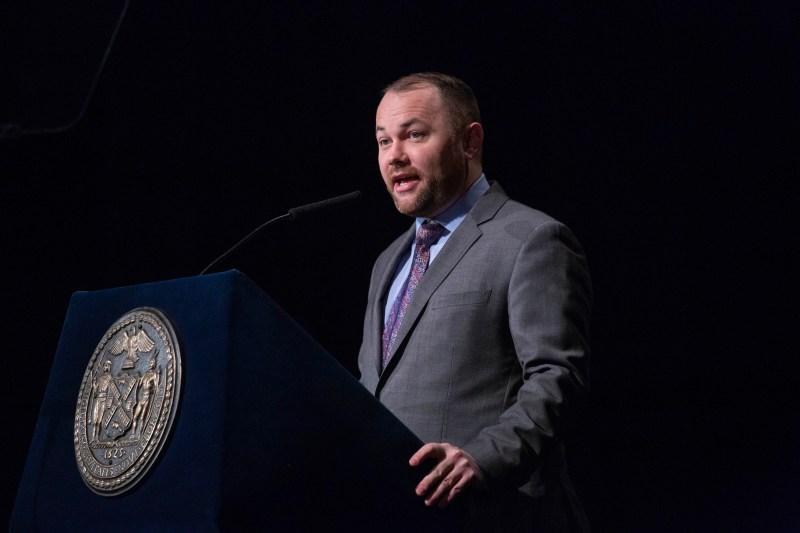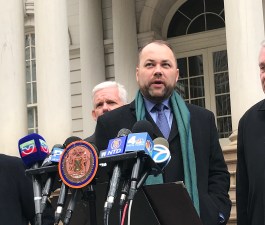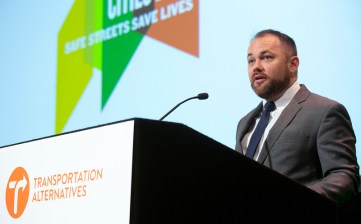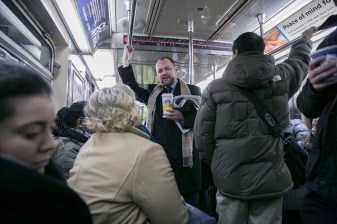Corey Johnson Just Exposed NYC’s Leadership Gap on Transportation
The city council speaker is running circles around Mayor de Blasio as Hizzoner's interest and intensity on the full range of livable streets issues wanes.

City Council Speaker Corey Johnson just showed a lame duck mayor how to fly.
Johnson’s all-transportation “State of the City” speech on Tuesday hit all the right notes. Yes, he mapped out a pie-in-the-sky plan for city control over the subways, which is unlikely to happen in the immediate future, as Streetsblog reported today. But even discussing such an idea — not to mention the eminently doable sweeteners like safer street redesigns, more plazas, better bike lanes, improved bus service and even removing part of the Brooklyn-Queens Expressway — shows just what can be accomplished by a New York City leader with persistent concern for, and consistent interest in, improving the city’s transportation system.
Simply put, in one short speech, Johnson closed the leadership gap that is plaguing the city in the waning years of an administration of a man who obviously has his eyes on his next job. More important, Johnson pushed the conversation about transportation policy further and more comprehensively than de Blasio has since his early and still-underappreciated Vision Zero days. Johnson didn’t pass the buck to the state — he pointedly argued that if the state won’t lead to make New York City more transit, bike and pedestrian-oriented, the city must.
Here’s where Johnson just served dessert on this lame duck administration:
Break the Car Culture
Johnson is far from the first City Council member to suggest the city needs to “break” its “car culture.” That distinction goes to his colleague, Antonio Reynoso.
But as speaker, Johnson has used the phrase, “break the car culture,” over and over again. He did again on Tuesday — and backed it up with proposals to make it happen: 50 new miles of protected bike lanes per year (up from Mayor de Blasio’s average of nearly 16 miles per year), 30 miles of new bus lanes per year, transit-signal priority on every bus route by 2030, increasing the number of “shared streets” in the city four-fold, reducing the size of the city’s vehicle fleet by 20 percent by 2025 — the list goes on and on.
He also called for pedestrianizing many areas of the city — something de Blasio has long resisted.
The City Council can do all of that through funding negotiations with the mayor — or through its discretionary funds.
Meanwhile, Mayor de Blasio continues to utter nonsense about how working New Yorkers get around and where their priorities are.
“We’re New Yorkers, we’re always concerned about parking,” he said last month. “It’s part of who we are.”
Johnson, who’s lived in the city for half as long as the mayor, showed what is possible when a mayor understands that New York is not, and should not be, a car-first city.
He’ll take matters into his own hands
With congestion pricing facing murky chances in Albany, Johnson re-upped his threat create a tolling system himself if the state fails to create what Governor Cuomo and Mayor de Blasio have both called an essential funding stream for public transit, yet seem powerless to actually get done.
“If Albany doesn’t pass congestion pricing this session, the City Council will,” he said. “We did it with speed cameras, and if we have to, we’ll do it again with congestion pricing.”
Johnson was referencing the council’s passage of its own speed camera program, which remains in place to this day. For years, common wisdom held that the city could not enact money-collecting speed cameras without state approval. Johnson and nearly every single council member rejected that argument, opting to exercise home rule authority to impose their own camera program.
Prominent legal scholar Frederick A.O. Schwarz Jr. has argued that the city can do the same with congestion pricing.
Compare that to de Blasio, who until last week refused to even back congestion pricing, deferring to the needs of a small number of people who drive into or through Manhattan’s central business zone. Given his long opposition, it’s unsurprising de Blasio proposed an alternative — a millionaire’s tax. But that alternative also passed the buck to Albany — where most observers agreed it was dead-on-arrival.
“This makes it a lot harder for [Albany] not to do [congestion pricing],” Council Member Brad Lander told Streetsblog after Johnson’s speech.
Since my post 20 months ago, 4 political changes point to passing c.p. in Albany: 1, @NYGovCuomo now a champion; 2, pro-c.p. insurgent Dems take Senate; 3, @NYCSpeakerCoJo brilliantly on board; 4, transit advocates are fierce and on-board. Fence-sitters: please take heed!
— Charles Komanoff (@Komanoff) March 5, 2019
Calling out the MTA’s broken oversight
Mayor de Blasio has said little to nothing about the MTA’s ineffectual board and excessive capital construction costs.
Johnson hit them head-on, calling attention to the organization’s structure, which he said was “designed to deflect accountability.”
“The MTA is an authority that’s controlled by the governor,” Johnson said. “But has its own budget, which is approved by a 17-member board with four mayoral appointee and seven suburban county appointees, but four of them only get a quarter of a vote, so technically it’s a 17-member board with 14 votes. And I’m not counting the six non-voting members, but if I did there would actually be 23 members. And the Mayor gets a veto, but not on everything — just capital projects, and only ones in the City.”
In place of that mess of supposed accountability, Johnson proposed a city takeover of the subways and buses — called Big Apple Transit — with a board made up of appointees of the mayor, borough presidents, and public advocate.
“All Big Apple Transit board members will be New Yorkers,” he said. “They will be required to use the system.”
The Johnson takeover acknowledges that the vast majority of the revenue for the subway system’s operation already comes from city riders, drivers and taxpayers. Yet the current MTA structure siphons off a disproportionate share of the money to other regional needs.
Questioning Cuomo’s commitment to NYC
Here’s how Johnson perfectly summed up the goal of his Big Apple Transit proposal: “It will never be in the best interests of any governor to put the needs of New York City above the needs of the rest of the state.”
Sadly, he’s probably right. Statewide elected officials can’t be bothered with meeting the narrow needs of the city’s whopping eight million residents when they also have to answer to voters in the suburbs and upstate.
For some reason, de Blasio never called that out. Until recently, de Blasio’s boilerplate response to questions about the city’s ailing transit system was that it wasn’t his problem or responsibility, since the MTA is a state agency. That was his response early in the L-train shutdown planning process. It was his response over and over again to pleas from advocates that the city fund the Fair Fares program. And it was his response to concerns about his cops blocking bus lanes and bike lanes all over the city.
Tackling the bike-lash monster
Streetsblog readers know the sequence well: Community members call attention to the need for better pedestrian and bike lane infrastructure. The city Department of Transportation proposes a street redesign providing it. Opponents come out of the woodwork. A few months later, neighbors are at each other’s throats. The bike lane gets installed — though sometimes if does not. And residents move on, resentful of their neighbors and the city, while the city has wasted valuable time and effort on something live-saving road safety strategies that should not even be debatable.
Johnson’s five-year master plan for city streets aims to disrupt that cycle of pain. As he sees it, the city’s street redesign efforts suffer from a lack of comprehensive planning.
“The master plan won’t eliminate all arguments over how we share our streets,” he said, “but it will allow us to understand how some neighborhood-specific changes fit into a larger plan for the greater good.”
Bike New York Advocacy Director Jon Orcutt, no stranger to bike lane and pedestrian plaza fights from his time as DOT policy director under Mayor Bloomberg, told Streetsblog that the master plan could help “take the temperature down” on the major spats that come up over relatively minor reallocations of parking spots for bike lanes.
“He’s right that we need to change that, and just change the conversation,” Orcutt said. “If you’re city DOT and you want to build a protected bike lane in a residential neighborhood, if you don’t have that kind of leadership backing you, it’s a million times worse.”
Needless to say, Orcutt thinks that leadership is severely lacking under Mayor de Blasio.
Taking on Robert Moses
On this particular topic, Johnson actually showed up Governor Cuomo, who often invokes Moses’s legacy as his inspiration for his desire to do big things like build a new Tappan Zee Bridge or renovate LaGuardia Airport.
But any student of urban history could tell you the dark side of Moses’s “master builder” legacy: destroyed neighborhoods, smog-filled highways cutting through the densest parts of the city, and the hundreds of miles of roads that created our present car-dependent mess.
“We have been living in Robert Moses’s New York for almost a century, and it is time to move on,” Johnson said.
He then proceeded to go where no NYC politician has gone before: He demanded a review of the de Blasio administration’s imagination-free plan to rebuild and replace the Brooklyn-Queens Expressway in hopes of coming up with something on a human scale — or no superhighway at all.
How’s that for leadership?
Corey Johnson ‘Let’s Go’ Transit Plan by Gersh Kuntzman on Scribd





